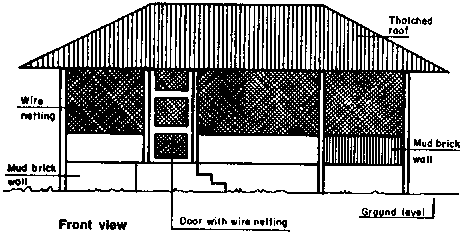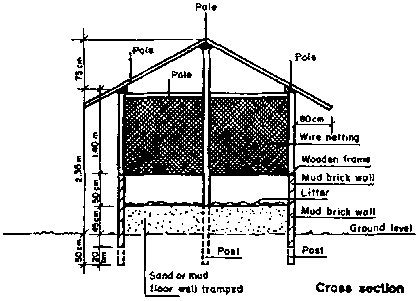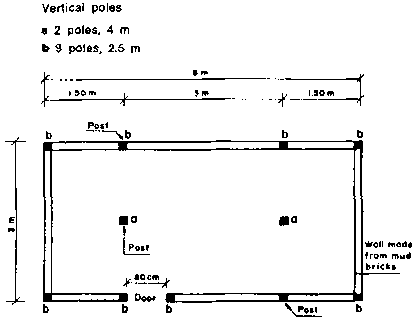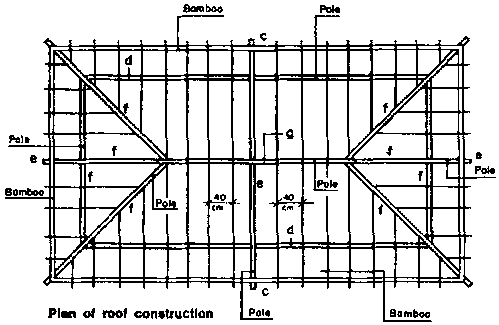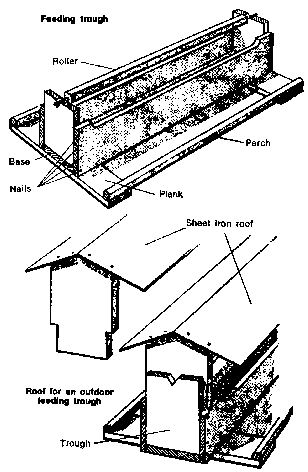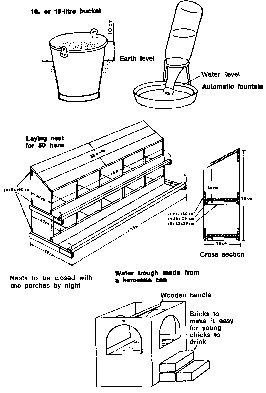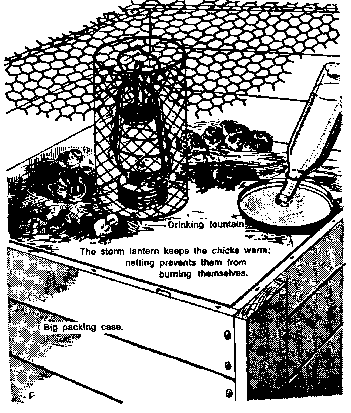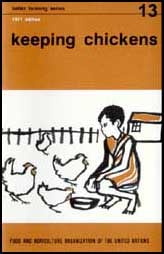
- (FAO - INADES, 1977, 48 p.)
How to house poultry[edit | edit source]
78. 100 birds at various ages need the following:
|
Space in the poultry house |
Drinking troughs |
Feeding troughs accessible from both sides | ||
|
Weeks |
Square metres |
Number |
Capacity, litres |
Length, metres |
|
1 |
4 |
2 |
4 |
1.2 |
|
2- 4 |
6 |
2 | ||
|
5-11 |
8-15 |
2 |
10 |
4 |
|
12 onward |
20-30 |
5-7 | ||
|
Adult birds |
30 |
7 | ||
NOTE: 1 metre of perch is sufficient for 5 or 6 adult birds.
How to build a poultry house[edit | edit source]
You will need:
5 poles, 4 metres
9 poles, 2.5 metres
2 poles, 8 metres
8 poles, 3 metres
1 pole, 3.5 metres 70 laths for the roof 17 mats Hay or straw for thatching Poultry wire netting, 22 metres One roll of wire Fittings for the door 300 mud bricks Sand Nails, 6 kilogrammes Inside all poultry houses put feeding troughs and drinking founts.
If you want to raise chicks, put in brooders.
If you want to raise laying hens, put in nests.
Front view
Cross section
Vertical poles
Floor plan Horizontal poles
|
c 2 poles, 8 m |
f 8 poles, 3 m |
|
d 2 poles, 6 m |
g 1 pole, 3.5 m |
e 3 poles, 4 m
Plan of roof construction
79. You can build the poultry house that was described without spending much money.
You make the walls of earth with wooden posts or with clay bricks.
You can make the roof with straw or with big leaves, or even with old sheet iron.
The ground of the poultry house must be well firmed. You can also cover it with concrete.
80. The poultry house must be built
Near the farmer's own house
Because he has to go to the poultry house several times a day.
On dry ground
Damp ground is dangerous for poultry, which get diseases as a result.
If the ground slopes, you must dig a ditch all round the poultry house to get rid of rain water.
Sheltered from sun and wind
You must build the poultry house in such a way that during the greatest heat it is sheltered from the sun, so that, in the evening when the heat is less strong, the sun can shine in.
Orient the ridge from east to west.
During the rainy season put mats and branches on the sides of the poultry house to prevent the rain and wind from getting in.
For 50 hens
The poultry house can be: 4 metres wide x 4 metres long x 2 metres high.
For 100 hens
The poultry house would be: 6 metres wide x 6 metres long x 2 metres high.
Do not make solid walls more than 0.5 metre high. Close the remainder of the space with wire netting or bamboo laths.
Nests[edit | edit source]
81. In the poultry house put wooden boxes or baskets. Put straw into them. These are the nests in which the hens lay eggs.
Collect the eggs three times a day: every morning, at noon, and in the evening.
There should be a sufficient number of nests. You need one nest for every five hens.
On page 43 a laying nest for 50 hens is shown. The perches are hinged so that they can fold up and enclose the nests at night.
82. Poultry rune
These are needed so that the poultry can walk about and find green grass, insects, worms. Put a fence round the run so that the poultry do not run about everywhere, and to protect them against animals.
Leave trees to give shade.
Divide the run into two parts. One part only is used while grass is growing again in the other part.
The runs should be big enough: for 50 hens you need a run about: 25 metres wide, 20 metres long.
Feeding troughs[edit | edit source]
83. Feeding troughs should be sufficient in number and long enough for each bird to have its place when it wants to eat.
Feeding troughs should not be too wide, so that the birds cannot leave their droppings in them.
Hollowed out bamboos could be used, for example.
On the next page Is a good type of feeding trough. It can be made In the village.
Nail the bottom of the trough to two planks. To the right and left of the trough nail two perches.
The sides of the trough are made of thinner boards. They are higher if the trough is for hens.
They are lower if the trough is for chicks.
To prevent the hens from leaving their droppings in the troughs, add a wooden bar that turns (a roller).
If the trough is outside the poultry house, make a little roof of sheet iron.
In that way the food is sheltered from the rain and stays clean.
Take off the roof to fill the trough.
Feeding trough; Roof of an outdoor feeding trough
Drinking troughs and fountains[edit | edit source]
84. The hen drinks a great deal.
A hen can drink more than a quarter of a litre of water a day.
Drinking troughs must:
- be big enough and in sufficient numbers to hold plenty of water;
- be big enough for a number of birds to drink without getting in each other's way;
- keep the water clean;
- not let the chicks fall into the water.
You can use:
Bowls or buckets put on a stand or let into the ground and partly covered by netting.
Home- made drinking troughs and fountains with founts
For chicks: put the water in a shallow bowl or can at which the chick can drink easily; take a bottle and fill it with water; turn the bottle upside down and put the neck in the bowl; lean the bottle against a wall or make a support as shown on page 43.
As the chick drinks, the water in the bottle flows into the bowl.
An ordinary 10- or 15- litre bucket serves very well too. Sink it in the ground so that only about 10 centimetres are out. Be sure to change the water frequently.
You can make a very good drinking trough from an old kerosene can, as shown on the facing page.
Bought drinking troughs with founts.
If you have a lot of poultry, and you take very good care of them, and if you can sell them easily, it is better to buy drinking troughs with founts.
Poultry
The brooder[edit | edit source]
85. If you buy day- old chicks, you must protect them from cold and from animals - rats, snakes, cats.
Put the chicks in the brooder for three or four weeks.
To protect the chicks from predatory animals put them in a big wooden case or In a big basket. See the picture on page 45.
Put netting over the top.
To protect the chicks from cold, put a storm lantern in the middle.
Surround the lantern with netting so that the chicks do not burn themselves.
A storm lantern gives enough warmth for 20 to 40 chicks.
Reduce or increase the warmth when the chicks are too warm or when they are too cold.
The chicks are too warm when they go away from the lantern.
The chicks are too cold when they crowd up to each other.
To feed the chicks, put a feeding trough and a drinking fount inside the brooder.
The case is covered with netting to protect the chicks from dogs and cats.
The case is covered
How to choose and look after hens to produce chicks[edit | edit source]
Summary
86. Choose hens of a good breed, that do not have pullorum disease.
Mate them with a cock of good breed that also does not have pullorum.
In that way the eggs are fertilized: they produce chicks.
Choose hens that give a lot of big eggs.
In order to know which hens produce a lot of big eggs, they are made to lay in nests that close after the hen has gone in.
Choose hens that sit on the eggs.
These hens should be big, in good health and have plenty of feathers.
Separate them from the other hens.
Put them in a corner of the poultry house surrounded by netting, with a feeding trough and drinking trough with fount.
Feed them very well and protect them well against parasites.
As broody hens do not move, they can easily catch parasites.
Kill these parasites with wood ashes or with products that are sold for the purpose.
Here is an example[edit | edit source]
37. I am a farmer:
I have very little money to spend but all the same I want to keep chickens. Then my family and I can eat more meat. I can give my children more eggs. I can sell hens and eggs and have more money.
What can I do?
I must buy as little as possible.
I shall use as much as possible what I can find in the village, such as wood, remains of food and the harvest.
I shall look after my poultry with great care.
- I choose the sue.
- I build the poultry house.
All I have to buy is a few nails, a few planks and a little netting. For the roof, the walls, the fence, and the troughs I use what I find in the village.
At the animal husbandry centre I buy chicks.
They are not sexed: there are males and females. When the chicks are two months old I separate males from females. I dispose of the males when they weigh 1 kilogramme or more.
- I vaccinate the chicks.
- I feed my poultry
with grain that I produce myself, with the remains of food and harvests, with green grass or vegetables.
- I take as food for my family
the young cocks, the eggs, hens that have ceased to lay.
- 1 sell
the cocks that my family does not eat, the eggs that my family does not eat, the rejected hens that my family do" not eat.
